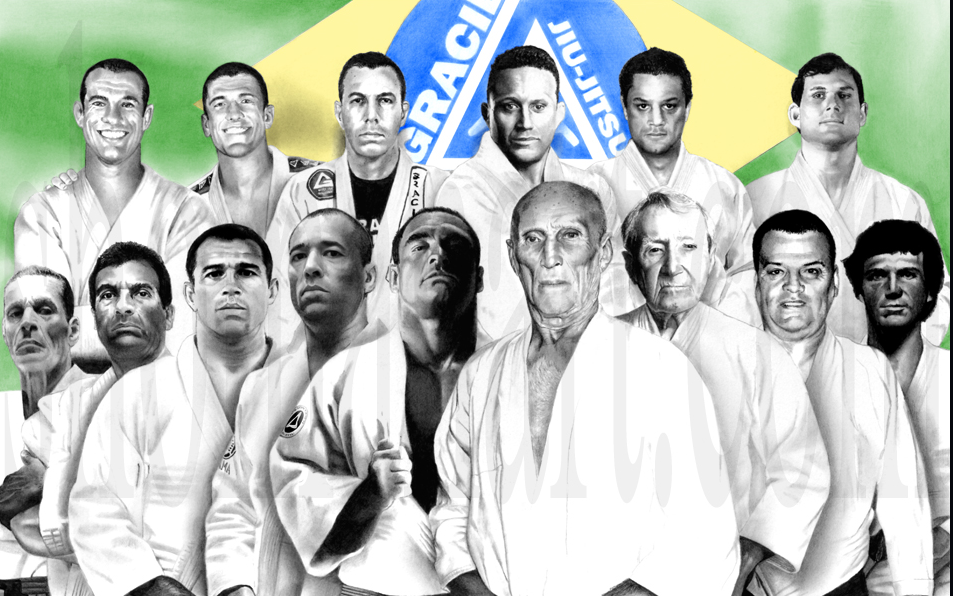About Jiu Jitsu

HISTORY OF JIU JITSU
Origins
Mitsuyo Maeda, one of five Kodokan's top groundwork experts trained by judo's founder Kano Jigoro, was sent overseas to demonstrate and spread his art to the world. He left Japan in 1904 and visited a number of countries giving "jiu-do" demonstrations and accepting challenges from wrestlers, boxers, savate fighters, and various other martial artists, and arrived in Brazil on 14 November 1914. Maeda had trained first in sumo as a teenager, and after the interest generated by stories about the success of Kodokan judo at competitions with other jujutsu schools of the time, he became a student of Kano.
Maeda & Gracie
Gastão Gracie was a business partner of the American Circus in Belém. In 1916, Italian Argentine circus Queirolo Brothers staged shows there and presented Maeda.
In 1917 Carlos Gracie (eldest son of Gastão Gracie) watched a ‘Kano Jiu-Jitsu’ demonstration by Maeda at the Da Paz Theatre and decided he wanted to learn. Maeda accepted Carlos as a student. He taught Carlos for several years (perhaps 5–6 years), eventually passing his knowledge on to his brothers. Gracie's account of the events is that his younger sibling Hélio Gracie gradually developed Gracie jiu-jitsu as a softer, pragmatic adaptation that focused more on the ground fighting and leverage aspect of Jiu-Jitsu/Judo (ne-waza) rather than the throws, as he was unable to perform many Judo throws, due to his size, that required direct opposition to an opponent's strength.
Brazilian jiu-jitsu focuses on getting an opponent to the ground in order to neutralize possible strength or size advantages through ground fighting techniques and submission holds involving joint-locks and chokeholds. On the ground, physical strength can be offset or enhanced through proper grappling techniques.
BJJ employs a wide range of takedown techniques to bring an opponent to the ground such as "pulling guard", which is not used in other combat sports such as Judo or Wrestling. Once the opponent is on the ground, a number of maneuvers (and counter-maneuvers) are available to manipulate the opponent into a suitable position for the application of a submission technique. Achieving a dominant position on the ground is one of the hallmarks of BJJ, which includes effective use of the guard position to defend oneself from bottom (using both submissions and sweeps, with sweeps leading to the possibility of dominant position or an opportunity to pass the guard), and passing the guard to dominate from top position with side control, mount, and back mount positions. This system of maneuvering and manipulation can be likened to a form of kinetic or physical chess when executed by two experienced practitioners. A submission hold in BJJ is often assimilated to the equivalent of "checkmate", where the opponent is left with no other option but to tap, be injured, or choked.
Renzo Gracie wrote in his book Mastering JUJITSU:
"The classical jujutsu of old Japan appeared to have no common strategy to guide a combatant over the course of a fight. Indeed, this was one of Kano's most fundamental and perceptive criticisms of the classical program." Maeda not only taught the art of judo to Carlos Gracie, but also taught a particular philosophy about the nature of combat developed by Kano, and further refined by Maeda based on his worldwide travels competing against fighters skilled in a wide variety of martial arts.
The book details Maeda's theory as arguing that physical combat could be broken down into distinct phases, such as the striking phase, the grappling phase, the ground phase, etc. Thus, it was a smart fighter's task to keep the fight located in the phase of combat best suited to his own strengths. Renzo Gracie stated that this was a fundamental influence of the Gracie approach to combat. These strategies were further developed over time by the Gracie family, among others, and became prominent in contemporary MMA.
Ground fighting
Brazilian Jiu-Jitsu is mainly differentiated from other martial arts by its greater emphasis on ground fighting. BJJ places less emphasis on standing techniques, such as striking and throws, although takedowns score points and the rules allows for a diverse range of techniques such as single, double leg takedowns, or foot sweeps. Some BJJ practitioners also cross train with wrestling, judo, and sambo.
Training methods
As BJJ focuses on submissions, sparring and live drilling become the most essential part of the training regime, this type of training allows practitioners to practice at full speed and with full strength, resembling the effort made in a competition. Training methods include drills in which techniques are practiced against a non-resisting and resisting partners; isolation sparring (commonly referred to as positional drilling) where only a certain technique or sets of techniques are used; and full sparring where each practitioner tries to submit their opponent through technique. Physical conditioning is also an important aspect of training.
The Gracie family lineage descended from Helio Gracie focuses on practical applications of BJJ that apply primarily to self-defense. They will often run development drills in which a person is surrounded by a circle of other students who will attempt to attack the defending student, who in turn must defend themselves using techniques.
Free Trial Class
Thanks for contacting us!
We will be in touch shortly.If you contacted us outside of business hours it might take us a bit longer to respond.
